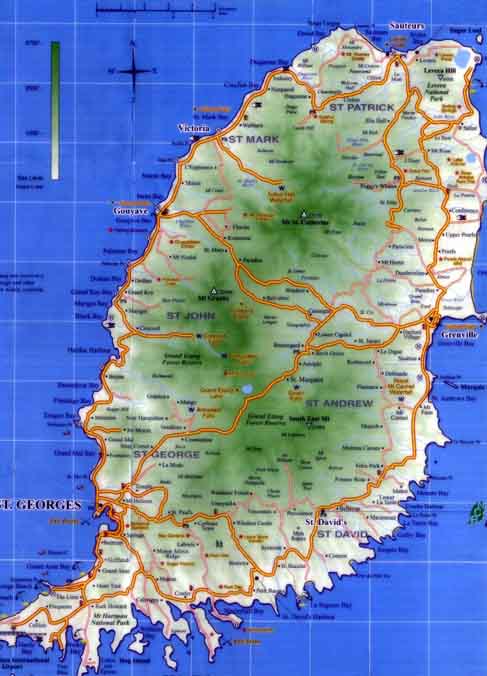
-
- Grenada Map
|
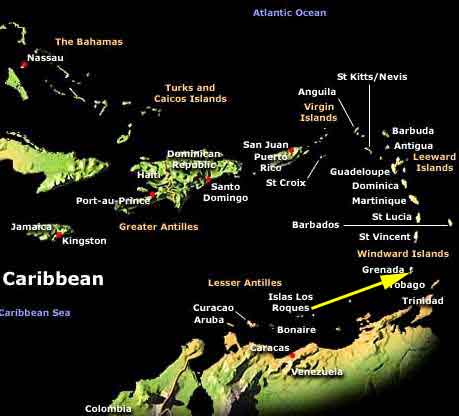
- Map of the Caribbean
|
click a picture
to see details |
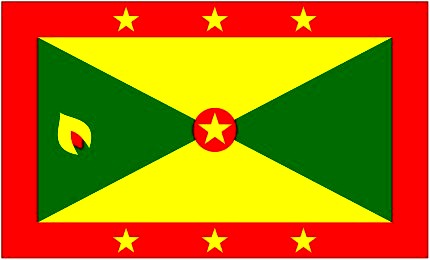
|
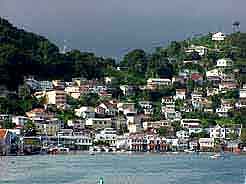
|
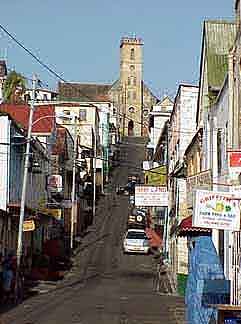
|
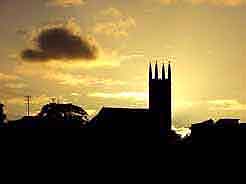
|
- The famous inner harbor of St. George's „The Carenage“ spreads a Northern
feeling
|
- Church Street, the narrow and
- steep main road of St. George's
|
- The silhouette of a church
- tower at sunset
|
- Grenada - The Island of Spice
The rhythms of the Trinidadian Steel Band on the upper deck of our car ferry “MV
Panorama” spread already a festive mood among the 600 passengers from Trinidad on
their way to the Carnival of Grenada. The joy of being able to attend a Caribbean Carnival
for the first time takes possession of us too – it doesn’t have to be the
world’s second famous of Port-of-Spain. How did it happen? As usual, we were having
our breakfast at the wonderful viewpoint at Fort George overlooking Port-of-Spain as we
got attentive to a radio ad which made promotion for a Carnival-Ferry sailing to Grenada.
Would this not be a possibility for us, we both thought at the same time. This idea did
not get out of our mind again. Thus we immediately set off to the harbor, where we could
talk to the manager who gave us the telephone number of the charter company. We were lucky
to get the responsible boss at the phone who proposed the following deal: “You buy
two passenger tickets for the Carnival and we take your car for free!” (it remained
the only vehicle on board). What a beautiful surprise!
-
-
|
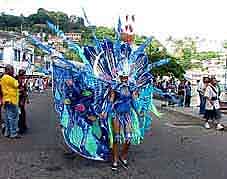
|
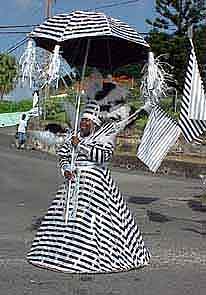
|
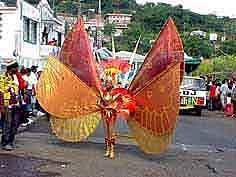
|
- Costume in Blue
|
- The Calypso Queen is the
- uncontested beauty
|
- The butterfly costume is only
- one of the many motifs
|
-
-
- It is a wonderful moment, as on August 9th, we approach St. George’s and our eyes
catch the attractive view of the capital, showing its full beauty in the warm evening
light. Old trading houses of the 19th century in soft pastel colors harmonically line the
horseshoe bay at the foot of a lush green hill. There are no high rise buildings, only
three church towers, as the law prohibits building higher than a coconut tree. Behind the
town, lush green vegetation in all shades is climbing up to the highest of the peaks. The
quiet bay is dotted with picturesque fishing boats, island hoppers and yachts from all
over the world. No wonder that this capital is famous for having the most beautiful harbor
of the whole Caribbean. For us, there is still more: We experience a touch of Europe, may
be even a certain Northern flair. It is for sure that it is completely different from
Trinidad & Tobago, our first two Caribbean islands. The Northern character even
increases as we stroll along “The Carenage”, the picturesque promenade which
surrounds the inner harbor, and admire the neat small “Nordic” houses lining the
narrow and very steep roads leading up the hills.
-
-
|
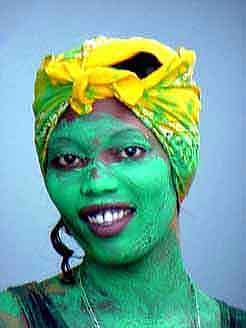
|
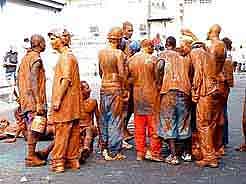
|
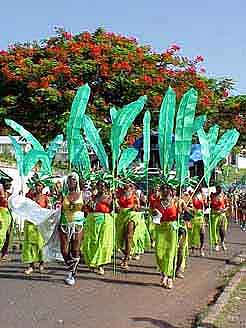
|
- One of the green painted
- faces at the morning parade
|
- A group of youngsters
- are covered with red clay
|
- The colorful parade
- is advancing
|
- The immigration formalities take place on board and are very easy going. We get a permit
to stay until the end of September. With the car papers, it does not work out as well as
we thought and wished. We had the confirmation that the customs procedure would be made
today. But the port officers do not know anything about it – one even meant that it
is a bad idea to bring a car to Grenada. Additionally, today is Saturday and the beginning
of the yearly Carnival. So we are not really astonished that it does not work out. But
this cannot change our good mood, the more that we are allowed to sleep in our car right
in the harbor and are able to use the shower facilities of the port security. Soon it
shows that this “forced camping” is actually very positive, as we are situated
right in the center of all the happenings which take place around the clock. And after a
cloudless and very hot day, in the evening we are very happy to feel the cooling breeze
around our heads on our preferred spot at the “Windjammer” docking and study the
flags of the many sailing boats lying quietly off shore to question their nationality.
-
-
|
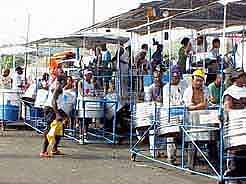
|
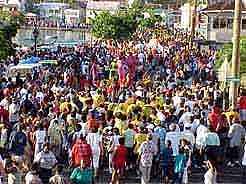
|
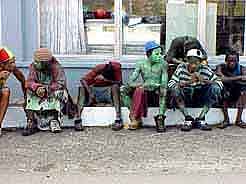
|
- The hot rhythms of the Calypso
- Steel bands cheer up everybody
|
- Soon, there will be no
- space even for a needle!
|
- Also the most intrepid ones need a rest
|
-
-
- Within the shortest of time, we meet sailors from France, Canada and Switzerland, who
chose the protected bays of Grenada to wait for the end of the hurricane season on
November 30th. It is interesting to realize that besides the ”real” sailor
enthusiasts, there are also the so called “hangers”, those who spend most of the
time on their boats at the same spot, anchoring off shore where it is for free, and
occasionally move to a neighbor island. Among them are also very run down characters. We
see them mostly in the supermarkets and Internet Cafes. One day, we meet Esther and Willy,
both Swiss, and have a nice chat together. They tell us that they are sailing mainly
between Grenada and Martinique. We ask them why they chose particularly this island in the
South to remain during the hurricane season. Their answer is interesting:” No company
insures sailing boats during the stormy time north of the 13th latitude, and apart from
that we are just in love with this little sleepy place”. Lilo - also Swiss - who
manages a Batik shop in the old city, shares their feelings. She also arrived once by
sailing boat and got stuck here. Today, the 63-year ‘young’, who in the
70’s explored Africa with a VW-Volkswagen bus, lives on her boat on Hog Island
together with her Rastafarian boy friend and speeds every morning with her little dinghy
20 minutes to work – we are impressed! “It is a good life”, she explains,
what we believe her! Who is not dreaming to awake every morning with the Caribbean sun and
being always surrounded by a turquoise sea? Also the Dutch and his Guyanese young wife who
regularly buy diesel in Venezuela and distribute it to other islands found their way to
combine work with their dream destination.
-
-
|
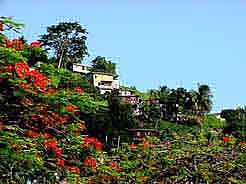
|
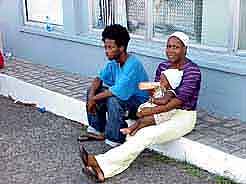
|
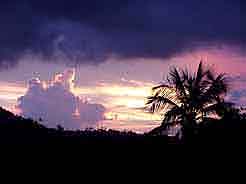
|
- Many houses nestle on lush green hills
|
- A little rest on the side of a road
|
- The colorful sunsets are
- always a beautiful sight
|
- On Monday morning at six o’clock, drum rhythms and calypso music make us jump out
of the bed. The Carnival is already in full swing – it started in the middle of the
night with a traditional parade called “J’Ouvert”. Afraid that we might
miss something, we are dressed in the shortest of time and swallow just a quick breakfast.
When we reach the street, a dancing crowd is just passing by, following a steel band in
full action. Many of them are covered with green, silver and blue paint. But we discover
also “Devils” full of black grease all over looking for people to smear. This is
the reason why we have been warned to wear only worn-out clothes on this morning parade.
Soon we are part of the slowly moving crowd and it is not difficult to be immediately
caught by their mood to celebrate. In the early afternoon, the main parade is formed and
soon the streets are full of colorful, beautiful costumes and groups which compete
regarding Carnival motifs and varieties of ideas. For us, it is a wonderful experience to
watch the whole procession from the little bridge in front of the stadium - passing by
right in front of our eyes - and it is also a very special welcome to Grenada, the usually
sleepy southerly Caribbean island.
-
-
|
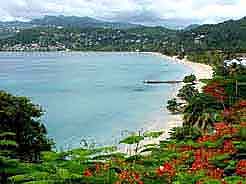
|
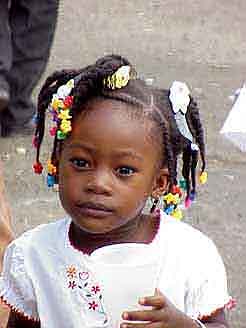
|
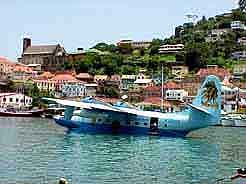
|
- The white beach of Grand Anse near
- St. George's is the most popular beach
|
- The Caribbean girls look always
- lovely with their plaited hair and beads
|
- The water plane is an ideal mean
- of transport for the outer islands
|
- At 2am on Wednesday, the “MV Panorama” left Grenada back to Trinidad, where it
will resume its normal service between the main- and its sister-island of Tobago again.
And we have to start with the entry procedures for our LandCruiser. It is really
surprising how fast and easy it is until we are able to drive on Grenada’s roads. In
less than two hour’s time, we already leave the port. Our LandCruiser is now
decorated with a local, yellow license plate carrying the number “V1” which
means “Visitor 1”. We are a bit proud to be the first visitors with an own car
on this island. Soon we realize that too many cars circulate already in St. George’s,
especially mini taxis which force their way through the ever congested narrow one line
streets, blocking them even more. How will this chaos end when in November the big cruise
ships call in again and release 3’000 passengers at once? And how will this small
town with only 4’500 inhabitants handle the situation when the new - in our mind too
big Cruise Ship Terminal - will be finished, which can accommodate three of those monsters
at the same time. But Grenada lives mainly from the cruising tourism, besides the export
of nutmegs and some bananas.
-
-
|
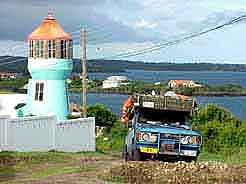
|
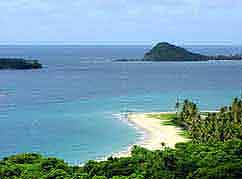
|
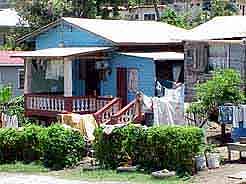
|
- Our LandCruiser with the local
- license plate V1 = „Visitor #1“
- at the light tower Anse aux Epines
|
- A touch of Pacific: The deserted
- Levera Beach with its offshore
- Sugar Loaf Island
|
- The traditional houses in
- Sauteurs are colorful
|
- Now in the rainy season – actually we don’t feel much of it - this mountainous
island looks to us all over like one single lush green park, dotted with wonderful exotic
plants, flowers and fruit trees. Everything is blooming and growing in excess: nutmeg,
cacao, bread fruit, mango, grapefruit, oranges, and guava, only to mention a few –
the fruits literally grow into our mouth - and the scent of cinnamon, clove and vanilla is
hanging delicately in the tropical air. Nestled between the lush vegetation are luxury
villas, but mainly simple wooden houses. We watch an old woman who cleans her yard with a
broom made of leafs; we watch naked children swimming in jungle rivers while their mothers
or sisters do the laundry; we watch people carrying piles of wood or fruits on their head;
and we watch the goats and cows graze on fat meadows – it is a peaceful rural
atmosphere.
-
-
|
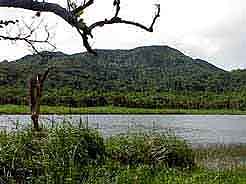
|
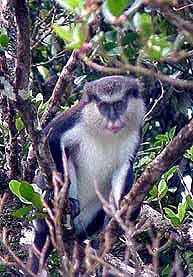
|
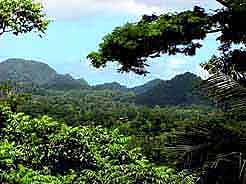
|
- The crater lake of Grand Etang
- National Park is a little oasis
|
- The Mona monkey in the Grand
- Etang National Park waits for bananas
|
- View of the lush green hills from
- the rooftop of „our“ house
|
-
-
- Which ever road we drive, along the East or the West Coast or across the interior, we
always wind our way through steep hills and discover many nice spots along the road, which
invite for a stop. On the South East Coast it is Lower Woburn with Hog Island in front,
then Point of Fort Jeudy, where the coast is wilder and with its low growing grass and
bushes remembers once more to distant Northern regions. La Sagesse Bay with its two
beautiful little bays of white sand and a restaurant in between is a place we will not
forget so easily also for another reason: Exactly on the last few, badly potholed yards to
this attractive point a smell of smoldering reaches our nose. Immediately, Emil turns off
the engine and realizes that the cause is the burning compressor of our little
refrigerator. But we still have hopes to be able to fix it. Time shows that after nearly
six years of providing us cool beer, it cannot be repaired anymore – a hard
knock-down for us!
-
-
|
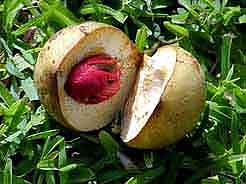
|
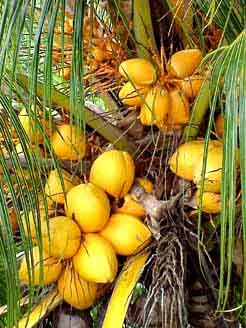
|
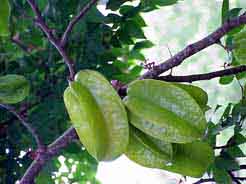
|
- Nutmeg, the main export
- product of Grenada, has its
- symbol also in the country's flag
|
- The milk of the coconut is a
- delicious drink of the tropics
|
- The sour star fruit looks
- very decorative when cut
|
-
-
- Most of our days we spend in the North Eastern corner in Bathway with its still deserted
beaches. We are allowed to lodge in the empty house of George Dias, whom we met at a
Christmas party in Georgetown/Guyana. It is situated on a hill, overlooking on one side
the forested hills and on the other side the three “Robinson” islands of Sugar
Loaf, Green and Sandy Island. Exotic flowers and mangos, guavas and star fruits grow
plentiful in the well kept garden – and all of them are just beautifully ripe to eat!
We feel a bit like Adam and Eve in paradise! The beach, with its pearl white sand,
turquoise sea and the swaying palm trees is only half a mile away, but a miserable stretch
downhill through an awfully washed out river bed. During the week, we have the beach for
ourselves, but on weekends we keep away when trucks arrive with loads of people for
partying, what normally ends with drunkenness. That’s when we prefer to sit on
“our” rooftop, enjoying a “sundowner” in the evening and watching the
sunsets, which always present a new spectacle with new colors and intensities.
-
-
|
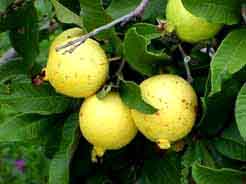
|
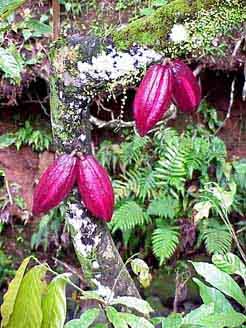
|
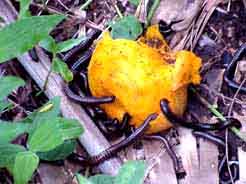
|
- The Guava fruit is found
- abundantly in Grenada
|
- Cacao belongs also to the fruits,
- which grow in Grenada
|
- Black centipedes are
- feeding on a ripe Mango
|
-
-
- The days are relaxing and we never get bored. Emil always can keep himself busy with the
computer, and I discovered in George’s interesting library the book of Wilfred
Thesiger “Arabian Sands”, which I always wanted to read. Soon I start to dream
of desert sand, bedouins and camels. Is it time for a change? But already the next moment,
I dismiss this idea when my eyes wander through the lush green surroundings, sensing the
intensity of the colors, the different shapes of the plants and see the colorful feathers
of the birds. Then I know that this is still the place where I want to be now. The place
where every morning we enjoy the wonderful singing of a small, tame bird, where we expect
the visit of a shiny humming bird feeding on the sweet nectar of the purple flowers, and
where a bird of prey is waiting for hours on the same top on a pole shrieking loudly in a
regular interval. We even got accustomed to the many green lizards which crawl everywhere
and the countless black centipedes – or were they millipedes? - which feed on the
ripe fruits. There are only two things we could easily miss: The hordes of black flies and
mosquito’s pestering us and the nearly unbearable heat in the night when we lay
motionless under a mosquito net and are trenched in sweat. May be it has to be that way to
make our departure less hard. There is definitely no real paradise on earth!
-
-
|
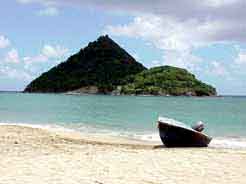
|
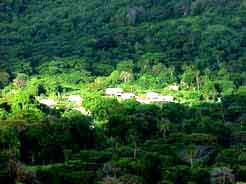
|
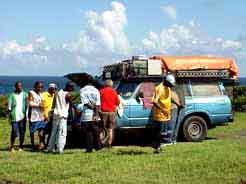
|
- A fishing boat waits for passengers
- to the Sugar Loaf "Robinson Island"
|
- View from „our“rooftop to a
- hamlet nestled in the dense forest
|
- Mazda mechanics want to inspect
- the engine of our LandCruiser
- and eat our sausages
|
-
-
- We cannot collect many miles on Grenada. The island measures only 133 square miles and
is home of 98’000 English speaking people: 82% are Negroes, 13% mixed and 3% of
Indian origin. The population intensity is 737 inhabitants per square mile (USA has 78).
Grenada has been ruled by the English and by the French before it became independent on
February 7th, 1974. One of our last visits before we say good-bye to Bathway brings us to
the small village of Sauteurs in the North, where the last battles between the islanders
and the conquerors took place. It is said that 1651 the last families of the aggressive
tribe of the Carib Indians jumped over a 135 feet high cliff, called “Carib’s
Leap” into the sea rather than to be taken prisoners by the approaching French.
-
-
|
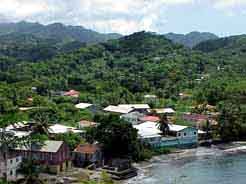
|
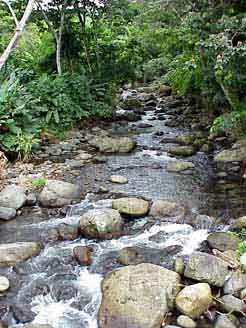
|
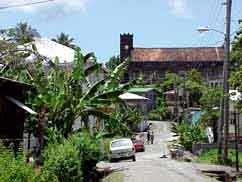
|
- The neat village of Sauteurs
- between sea and mountains
|
- A wild jungle river in the
- interior is a place to cool off
|
- The island character of this
- village street in Sauteurs is obvious
|
-
-
- Then we are back in St. George’s again. While we are checking out the shipping
possibilities to our next destination St. Vincent, we are allowed to spend the nights on
the compound of the local Toyota distributor. Nicholas Steel, the owner, is very helpful
and assists us even in finding a vessel. We happily accept also that his company is taking
over the freight costs as a most appreciated support of our big journey. “Mother
Luck” is smiling warmly on us again! When on September 4th, we leave Grenada with its
laid back charm, St. George’s is gleaming again in the same warm evening light as it
welcomed us 25 days before. We are standing at the reeling of the gravel boat “MV
Gondola” until night sets in. Then we enter the mess room and stretch out on a long
bench for a short night.
|
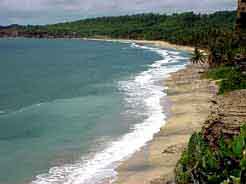
|
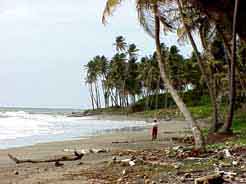
|
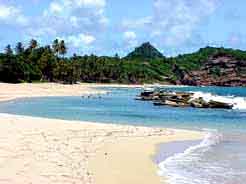
|
-
- The pristine Bathway Beach in the Northeast has different faces
|
- N.B. It was devastating to hear that one year later, hurricane “Ivan” - the
terrible, has destroyed 90% of this beautiful island. Our thoughts are with all the people
who crossed our way!
-
-
|
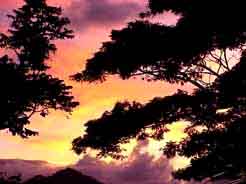
|
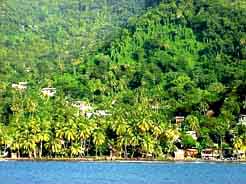
|
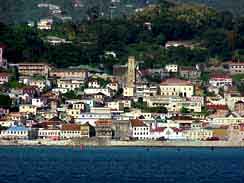
|
- The splendor of a tropical sunset
|
- Grenada’s West Coast is covered
- with palm trees and dense jungle
|
- St. George's is gleaming in the warm evening light at our departure
|
- Articles in newspapers about us in Grenada:
|
![]()